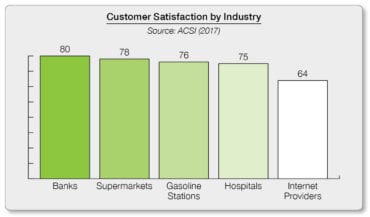Although providing excellent customer service is a necessary component for the success of most businesses, the healthcare industry has typically been slower to adapt practices that place a heavy focus on customer satisfaction. In fact, according to the American Customer Satisfaction Index‘s 2017 Utilities, Shipping, and Health Care Report, hospitals achieved a customer satisfaction score of 75 out of 100 for the second year in a row. This places the healthcare industry 32nd in customer satisfaction behind banks, supermarkets, and gasoline stations.
Fortunately, according to Beryl Institute’s State of PX 2017 Findings, 74% of health organizations have begun to place a greater emphasis on service excellence in recent years. This is partially in response to the recent shift in patients seeing healthcare as no different from other service industries and redefining themselves as consumers who are willing to spend time looking for the best health service available to them. Additionally, many lessons learned in other industries can be adapted to help inform improvements to customer service in healthcare.

Emphasizing Personalized Service
One of the primary pillars of customer satisfaction is providing personalized attention. In healthcare, this goes beyond a health practitioner simply greeting their patients with a smile or small talk about how their day is going. Taking advantage of the recent trends in customer self-service, healthcare organizations can implement patient-facing services that allow them to take direct control of their healthcare experience.
Some examples of such patient-facing services can already be found with the various portals that allow patients to view their health record, see test results, browse educational materials, pay bills, schedule appointments, and easily find contact information for their physician without assistance. For maximum convenience, these patient-facing portals will need to continue to be accessible from home computers, personal mobile devices, and ideally from self-service kiosks placed inside a hospital. By continuing broad-spectrum support of patient portals, organizations can save patients’ time and reduce the number of calls to administration, ultimately reducing cost for the organization in doing so.

Additionally, it is important that patients understand and are encouraged to provide feedback on their experiences. This can not only help patients gain confidence in their providers and feel like their feedback is being heard, but it also ensures that any serious or common issues are brought to the organization’s attention. Many health organizations offer follow-up surveys after an appointment and make it easy to send feedback on patient-facing portals.
For organizations that have yet to implement patient satisfaction initiatives, now is the time to do so. Patient satisfaction is a vital component for the success and continued improvement of any health organization. Simply by looking to other industries’ experiences with customer satisfaction interactions and adapting them for the healthcare space, organizations can improve satisfaction and realign care to closer fit patient feedback and preferences. It’s important to provide patients with the tools necessary to take charge of their healthcare experience and encourage feedback so that the healthcare industry can make positive progress toward improvements that put patient care first – and the healthcare industry higher on the list of top customer satisfiers.





